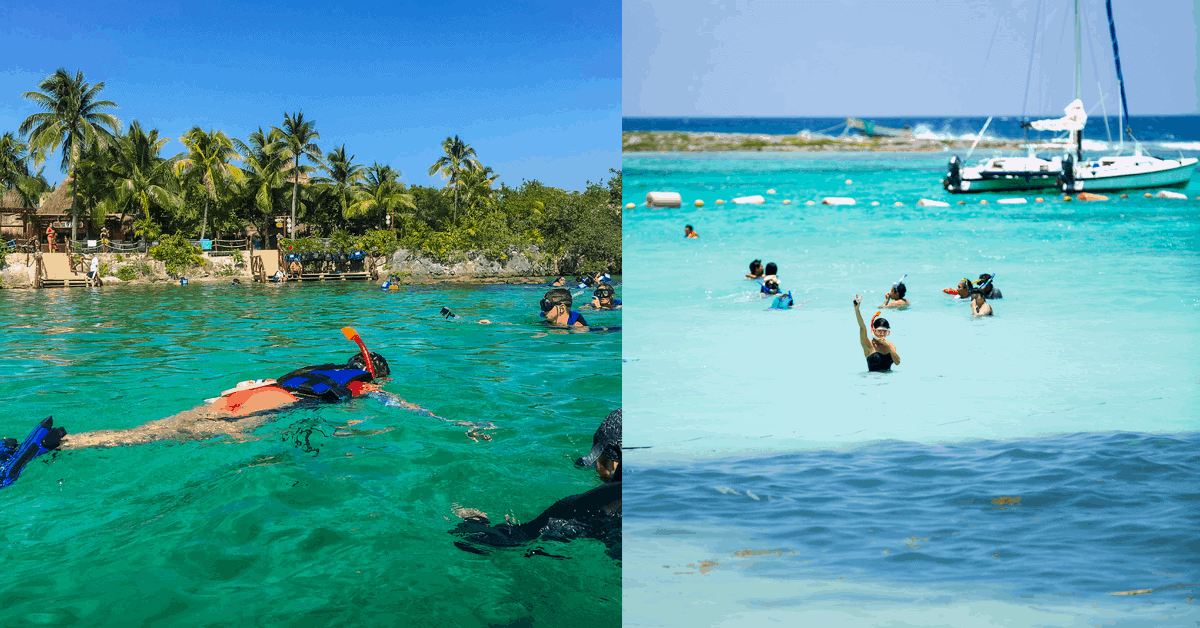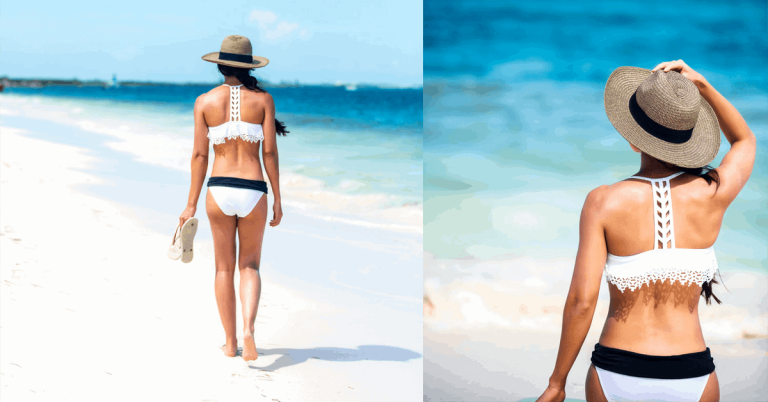The Best Snorkeling in Mexico is in The Riviera Maya

Riviera Maya the Best Snorkeling in Mexico
Snorkeling is a wonderful way to see the diversity that nature has brought to the Riviera Maya in Mexico, and many of the locations on this Caribbean side of the country are considered the best snorkeling in Mexico.
From Puerto Morelos all the way down to Xel-Ha, this 62-mile/100-kilometer stretch of ocean offers up cenotes, lagoons, islands, and the second largest coral reef in the world. You can find your own little piece of ocean heaven, stay cool on a hot day and, in some cases, contribute to the conservation of this precious part of the coastline.
In addition to seeing the largest coral reef outside of Australia’s Great Barrier Reef, you’ll witness a large variety of fish and plant life, and in some places, you will have the privilege of snorkeling with sea turtles. From fans to anemones, parrotfish to angel fish, moray eels to manta rays, you’ll be treated to a colorful assortment of underwater creatures that are sure to make you smile. At least that is what Peter and I experienced during our recent trip to this part of the world.
While we opted to rent a car and drive ourselves to snorkeling spots, there are tours available to all these areas and to some not accessible by car (farther out in the ocean, off the coast of Cozumel, etc.). If you have the time and opportunity, taking one of the tours is a nice change of pace and can be beneficial in learning more about these wonderful underwater sites.
Snorkeling Gear
While we brought our own masks, snorkels, and fins for snorkeling in Mexico, it is not necessary. Many resorts offer them for free or a small fee. Almost every popular snorkeling venue rents them as well, and if you take any kind of tour, the equipment will be included in the price. Life jackets are not required on public beaches (and don’t let anyone tell you differently), but they may be required at private venues and are recommended if you will be in the water for more than an hour or going out into deeper waters.
Note on Suncreen
Many of the best snorkeling in Mexico are protected ecosystems. This means that you cannot wear everyday sunscreen. You must use biodegradable sunscreen or go without. (You can opt to wear long-sleeve sunblock swim shirt.) If you don’t bring any with you, it is usually available for purchase at the venues.
So let’s get started with our rundown of some of Mexico’s best snorkeling locales, starting at Puerto Morelos and heading south to Xel-Ha.
Puerto Morelos Snorkleing
Located halfway between Cancun and Playa del Carmen, Puerto Morelos is a small fishing village that has become a premiere snorkeling destination and is known for its dedication to ecotourism. It is home to Parque Nacional Arrecife Puerto Morelos, which sits offshore on the Mesoamerican Barrier Reef (also known as the Great Belt Western Atlantic Reef). This is a protected ocean reserve and will require you to venture out with an organized tour operator; you are prohibited from swimming out on your own. You’ll also be restricted in your use of sunscreen (as mentioned above) and be required to wear a life jacket.
The Puerto Morelos Reef is part of the second largest coral reef in the world and is home to a visually stunning underwater garden comprised of anemones, brain fans, lobster, seahorses, and a variety of colorful fish. You may also encounter barracuda, manta rays, and the occasional sea turtle.
Cozumel Snorkeling
Cozumel, the island located across from Playa del Carmen, has some wonderful spots for snorkeling, both close to and off the shore. You’ll find good visibility with clear blue water, a vast array of sea life, and the availability to snorkel Cozumel on your own or with a tour. The Mesoamerican Barrier Reef extends through this portion of the ocean, and is located in the Parque Marino Nacional Arrecifes de Cozumel, offering additional opportunities for snorkeling.
We stayed at a resort on the island and were able to snorkel right off the beach. Our hotel, like many on Cozumel, offered snorkeling tours that appeared to be quite popular. Should you want to venture further out, there are a number of great snorkeling sites along the Cozumel coast.
Here are a few of best:
- Columbia Reef: This is a 5-star snorkeling site, accessible by boat or tour. You’ll see coral heads rising 10-30 feet above the ocean floor, as well as plenty of marine life—both large and small.
- Palancar Reef: Located out in the ocean, this reef will require a boat or tour. It is known more for its rocky landscape and towering formations, than its sea life. The coral does provide a source for some plant life and colorful fish, as well as sea turtles, but you will be in awe of this underwater netherworld. (If you SCUBA, this is the place to visit!)
- Dzul Ha: This beautiful white sand beach is a great way to spend your day relaxing and enjoying some great snorkeling in Mexico. The reef is close to the shore and the depth is relatively shallow at 10-15 feet. It isn’t super crowded and be warned that there is no public restroom on site. There are, however, multiple restaurants around to take a break and enjoy a meal or a drink overlooking the Caribbean.
Caves and Cenote Snorkeling
Cenotes (seh-no-tays) offer a much different type of snorkeling in Mexico than out in the ocean water of the Caribbean. These sinkholes, which occur due to the collapse of the surrounding limestone, become filled with freshwater. Cenotes can be open air (both near the ocean and inland) or within and between caves. Their waters are crystal clear, allowing you to easily see the fish and sea life within. They typically have dark, rocky bottoms rather than coral or an abundance of plant life. Because cenotes are like giant pools, they may be the easiest to snorkel, and are perfect for beginners.
There are a number of cenotes along the Riviera Maya. Three of the more famous and easily accessible are:
- Cenotes dos Ojos, close to Tulum, is comprised of two connected cenotes that look like eyes (hence the “dos ojos”) that are located in a cave system. Here you can snorkel between the caves, although the dark pool is a bit claustrophobic with a low ceiling. Stick to the vivid blue pool. You can also explore some of the caves on foot, admiring the stalactites and the bats that cling to them. There is an entrance fee of 100 pesos (≈ $5US) or 300 pesos for a guide and snorkeling equipment.
- Cenote Azul is located just south of Puerto Aventuras. This large cenote is perfect for beginners and families alike, and even has a cliff from which you can launch yourself into the cenote. You also have the ability of standing in some portions of Cenote Azul, rather than needing to float around, perfect for weaker swimmers. There is an entrance fee of about 80 pesos (≈ $4US) and equipment is available for rent.
- Cenote also located near Tulum is where Peter and I went snorkeling. It was amazing, to say the least!
Gran
Akumal Snorkeling
Akumal is a public beach where you can snorkel to your heart’s content. The beach itself is gorgeous, and the waters are warm and very calm. In fact, we found that we didn’t even need our fins. There are areas that are heavy with sea grass, so you might want to avoid them, but there are plenty of fish, sea life, and large sea turtles. In fact, you’ll have the opportunity to swim with Loggerheads, Hawksbill and Green sea turtles here in Akumal Bay. Because of this, Akumal gets a bit crowded from noon on, so try and get here earlier, so you have some time to yourself.
It took me about 45 minutes to find a sea turtle. It was huge! An amazing experience and I’d highly recommend checking this place out! I shared photos of Akumal Beach in a separate post so make sure to check it out!
TIP: Avoid the very aggressive individuals and tour operators trying to charge a fee to access the beach, rent snorkeling equipment, and insisting that life vests are mandatory. Bring your own equipment or rent from the dive shop, and know that life vests are optional, not mandatory. (And the beach is free!)
Xel-Ha Snorkeling
You might question my addition of Xel-Ha on this list, but I want to wholeheartedly support this eco-friendly aquatic theme park. I applaud their dedication to the environment, to preserving the coral reefs and marine life, and offering up an excellent snorkeling experience at the same time. Xel-Ha is perfect for beginners and families with its massive lagoon the center of the park that contains over 90 marine species.
The entrance fee is $80US, making it a full-day excursion. Included in your entry fee is your snorkeling equipment, lockers, restrooms, and showers. There are restaurants and bars scattered throughout, and there are other activities available with your entrance fee: you can travel the jungle trails by foot or bike, take a river tour, explore the Xel-Ha Cave, catch a zip line, or just hang out in a hammock with a fruity cocktail!
We spent an entire day here; it was so much fun!
NOTE: Because this is an eco-friendly resort, standard sunscreen is not allowed. You’ll need to buy or exchange your sunscreen for a biodegradable, eco-friendly sunscreen. (FACT: Approximately 100,000 chemical-free sunscreens are exchanged annually at Xel-Ha.)
I hope this post has helped you discover the best snorkeling in Mexico! The Riviera Maya definitely has no shortage of places to snorkel. No matter which of these locations you decide to go to I’m sure you’ll love it!
Stay Stylish,
-V





